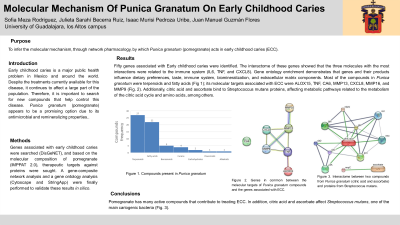Caries
356 - Molecular Mechanism Of Punica Granatum On Early Childhood Caries

- SM
Sofia Meza, Student (she/her/hers)
pediatric dentistry student
University of Guadalajara
University of Guadalajara
Guadalajara, Jalisco, Mexico - JG
Juan Manuel Guzman Flores, n/a
University of Guadalajara
Tepatitlan de Morelos, Jalisco, Mexico - CA
Carmen Celina Alonso Sánchez, University of Guadalajara, Pediatric Dentistry
Program director
Universidad de Guadalajara
Tepatitlan de Morelos, Jalisco, Mexico
Presenting Author(s)
Research Mentor(s)
Program Director(s)
Purpose: To infer the molecular mechanism, through network pharmacology, by which Punica granatum (pomegranate) acts in early childhood caries (ECC).
Methods: Genes associated with early childhood caries were searched (DisGeNET) and, based on the molecular composition of pomegranate (IMPPAT 2.0), therapeutic targets against proteins were sought. A gene-composite network analysis and a gene ontology analysis (Cytoscape and StringApp) were performed to finally validate these results in silico.
Results: 50 genes associated with CPB were identified. The interactome of these genes showed that the three molecules with the most interactions were related to the immune system (IL6, TNF and CXCL8). Gene ontology enrichment demonstrates that genes and their products influence dietary preferences, taste, immune system, biomineralization, and extracellular matrix components. Most of the compounds in Punica granatum were terpenoids and fatty acids; its molecular targets associated with ECC were ALOX15, TNF, CA6, MMP13, CXCL8, MMP16, and MMP9. Additionally, citric acid and ascorbate bind to Streptococcus mutans proteins, affecting metabolic pathways related to the metabolism of the citric acid cycle and amino acids, among others.
Conclusions: Pomegranate has many active compounds that contribute to the treatment of CPB. In addition, citric acid and ascorbate affect Streptococcus mutans, which is one of the main cariogenic bacteria.
Identify Supporting Agency and Grant Number:

.jpg)